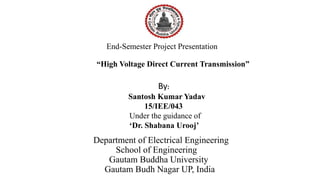This document provides an overview of a student's end-semester project presentation on high voltage direct current (HVDC) transmission. The presentation covers the history, working principles, components, advantages, disadvantages, applications, and future prospects of HVDC transmission. It was presented by Santosh Kumar Yadav to the Department of Electrical Engineering at Gautam Buddha University in India under the guidance of Dr. Shabana Urooj.














